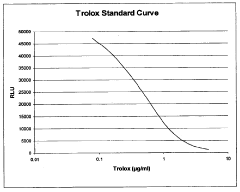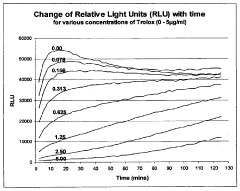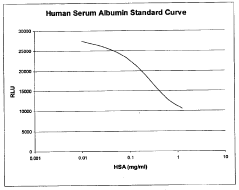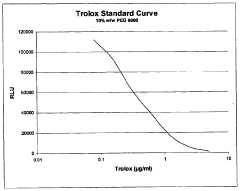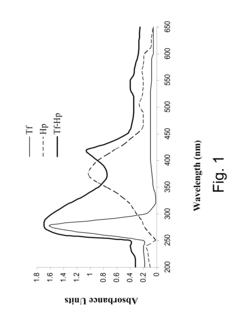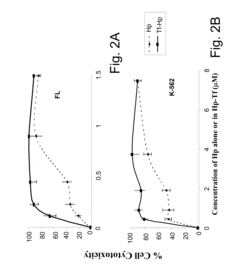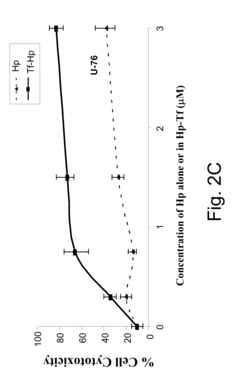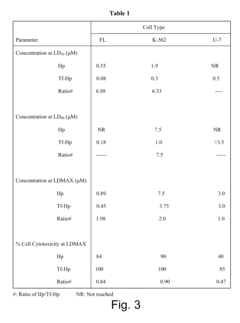Exploring Antioxidant Effects with Luminol Applications
AUG 19, 20259 MIN READ
Generate Your Research Report Instantly with AI Agent
Patsnap Eureka helps you evaluate technical feasibility & market potential.
Luminol Antioxidant Research Background
Luminol, a versatile chemiluminescent compound, has been a subject of scientific interest for decades. Initially discovered in the early 20th century, luminol's ability to emit light when oxidized has found applications in various fields, particularly in forensic science and biochemistry. However, recent research has shed light on its potential antioxidant properties, opening up new avenues for exploration in the realm of health and medicine.
The study of luminol's antioxidant effects is rooted in the broader context of oxidative stress and its impact on human health. Oxidative stress, caused by an imbalance between free radicals and antioxidants in the body, has been linked to numerous chronic diseases and aging processes. This has led to a surge in research focused on identifying and developing novel antioxidant compounds to combat these harmful effects.
Luminol's journey from a forensic tool to a potential antioxidant agent began with observations of its chemical structure and reactivity. Its ability to interact with reactive oxygen species (ROS) and other oxidizing agents suggested that it might possess antioxidant capabilities. This hypothesis has since spurred a wave of investigations aimed at unraveling the mechanisms behind luminol's antioxidant effects and exploring its potential therapeutic applications.
The research background of luminol as an antioxidant is characterized by a multidisciplinary approach, combining elements of chemistry, biochemistry, and pharmacology. Scientists have been working to elucidate the molecular basis of luminol's antioxidant activity, studying its interactions with various cellular components and its impact on oxidative stress markers.
One of the key areas of focus has been the investigation of luminol's free radical scavenging abilities. Researchers have conducted numerous in vitro and in vivo studies to assess its capacity to neutralize harmful free radicals and protect cells from oxidative damage. These studies have provided valuable insights into the potential of luminol as a therapeutic agent in conditions associated with oxidative stress.
Furthermore, the research background encompasses efforts to optimize luminol's antioxidant properties through chemical modifications and formulation strategies. Scientists have explored various derivatives of luminol, aiming to enhance its stability, bioavailability, and antioxidant efficacy. This has led to the development of novel luminol-based compounds with improved pharmacological profiles.
The evolving research landscape also includes investigations into the synergistic effects of luminol with other known antioxidants. These studies aim to develop more potent antioxidant formulations that could offer enhanced protection against oxidative stress-related disorders.
As the field progresses, researchers are increasingly focusing on translating laboratory findings into practical applications. This includes exploring the potential of luminol-based antioxidants in preventive healthcare, anti-aging products, and as adjuvant therapies in various disease conditions.
The study of luminol's antioxidant effects is rooted in the broader context of oxidative stress and its impact on human health. Oxidative stress, caused by an imbalance between free radicals and antioxidants in the body, has been linked to numerous chronic diseases and aging processes. This has led to a surge in research focused on identifying and developing novel antioxidant compounds to combat these harmful effects.
Luminol's journey from a forensic tool to a potential antioxidant agent began with observations of its chemical structure and reactivity. Its ability to interact with reactive oxygen species (ROS) and other oxidizing agents suggested that it might possess antioxidant capabilities. This hypothesis has since spurred a wave of investigations aimed at unraveling the mechanisms behind luminol's antioxidant effects and exploring its potential therapeutic applications.
The research background of luminol as an antioxidant is characterized by a multidisciplinary approach, combining elements of chemistry, biochemistry, and pharmacology. Scientists have been working to elucidate the molecular basis of luminol's antioxidant activity, studying its interactions with various cellular components and its impact on oxidative stress markers.
One of the key areas of focus has been the investigation of luminol's free radical scavenging abilities. Researchers have conducted numerous in vitro and in vivo studies to assess its capacity to neutralize harmful free radicals and protect cells from oxidative damage. These studies have provided valuable insights into the potential of luminol as a therapeutic agent in conditions associated with oxidative stress.
Furthermore, the research background encompasses efforts to optimize luminol's antioxidant properties through chemical modifications and formulation strategies. Scientists have explored various derivatives of luminol, aiming to enhance its stability, bioavailability, and antioxidant efficacy. This has led to the development of novel luminol-based compounds with improved pharmacological profiles.
The evolving research landscape also includes investigations into the synergistic effects of luminol with other known antioxidants. These studies aim to develop more potent antioxidant formulations that could offer enhanced protection against oxidative stress-related disorders.
As the field progresses, researchers are increasingly focusing on translating laboratory findings into practical applications. This includes exploring the potential of luminol-based antioxidants in preventive healthcare, anti-aging products, and as adjuvant therapies in various disease conditions.
Market Demand Analysis
The market demand for luminol applications in antioxidant research has been steadily growing in recent years. This growth is primarily driven by the increasing focus on understanding oxidative stress and its impact on various biological processes. Luminol, known for its chemiluminescent properties, has found significant applications in detecting and measuring antioxidant activity, making it a valuable tool in both research and industrial settings.
In the pharmaceutical industry, there is a rising demand for luminol-based assays to evaluate the antioxidant potential of new drug candidates. These assays provide rapid and sensitive methods for screening compounds, helping to accelerate the drug discovery process. The ability to quickly assess antioxidant properties is particularly crucial in developing treatments for age-related diseases, cardiovascular disorders, and neurodegenerative conditions, where oxidative stress plays a significant role.
The food and beverage industry has also shown increased interest in luminol applications for antioxidant testing. With consumers becoming more health-conscious, there is a growing demand for functional foods and beverages with proven antioxidant benefits. Luminol-based techniques offer food manufacturers a reliable method to quantify and validate the antioxidant content of their products, supporting marketing claims and ensuring product quality.
In the cosmetics and personal care sector, luminol applications are gaining traction for evaluating the antioxidant efficacy of skincare formulations. As the anti-aging market continues to expand, there is a heightened demand for products that can protect against free radical damage. Luminol-based assays provide cosmetic companies with a means to assess and demonstrate the antioxidant properties of their ingredients and finished products.
The research community represents another significant market for luminol applications in antioxidant studies. Academic institutions and research organizations are increasingly utilizing luminol-based techniques to investigate the role of antioxidants in various biological systems. This demand is fueled by ongoing research into oxidative stress-related diseases, environmental toxicology, and the development of novel antioxidant compounds.
Environmental monitoring and agricultural sectors are emerging markets for luminol applications in antioxidant research. There is growing interest in assessing the antioxidant capacity of soil and water samples, as well as evaluating the antioxidant content of crops and food products. These applications contribute to sustainable agriculture practices and food security efforts.
As the importance of antioxidants in health and various industries becomes more widely recognized, the market for luminol applications in this field is expected to continue its upward trajectory. The versatility of luminol-based techniques, combined with their sensitivity and ease of use, positions them as valuable tools across multiple sectors, driving sustained market demand for the foreseeable future.
In the pharmaceutical industry, there is a rising demand for luminol-based assays to evaluate the antioxidant potential of new drug candidates. These assays provide rapid and sensitive methods for screening compounds, helping to accelerate the drug discovery process. The ability to quickly assess antioxidant properties is particularly crucial in developing treatments for age-related diseases, cardiovascular disorders, and neurodegenerative conditions, where oxidative stress plays a significant role.
The food and beverage industry has also shown increased interest in luminol applications for antioxidant testing. With consumers becoming more health-conscious, there is a growing demand for functional foods and beverages with proven antioxidant benefits. Luminol-based techniques offer food manufacturers a reliable method to quantify and validate the antioxidant content of their products, supporting marketing claims and ensuring product quality.
In the cosmetics and personal care sector, luminol applications are gaining traction for evaluating the antioxidant efficacy of skincare formulations. As the anti-aging market continues to expand, there is a heightened demand for products that can protect against free radical damage. Luminol-based assays provide cosmetic companies with a means to assess and demonstrate the antioxidant properties of their ingredients and finished products.
The research community represents another significant market for luminol applications in antioxidant studies. Academic institutions and research organizations are increasingly utilizing luminol-based techniques to investigate the role of antioxidants in various biological systems. This demand is fueled by ongoing research into oxidative stress-related diseases, environmental toxicology, and the development of novel antioxidant compounds.
Environmental monitoring and agricultural sectors are emerging markets for luminol applications in antioxidant research. There is growing interest in assessing the antioxidant capacity of soil and water samples, as well as evaluating the antioxidant content of crops and food products. These applications contribute to sustainable agriculture practices and food security efforts.
As the importance of antioxidants in health and various industries becomes more widely recognized, the market for luminol applications in this field is expected to continue its upward trajectory. The versatility of luminol-based techniques, combined with their sensitivity and ease of use, positions them as valuable tools across multiple sectors, driving sustained market demand for the foreseeable future.
Current Challenges
The exploration of antioxidant effects using luminol applications faces several significant challenges in both research and practical implementation. One of the primary obstacles is the complexity of biological systems, which makes it difficult to accurately measure and interpret antioxidant activity in vivo. The intricate interplay between various cellular components and signaling pathways can confound results and lead to misinterpretations of luminol-based measurements.
Another challenge lies in the specificity and sensitivity of luminol as a chemiluminescent probe. While luminol is widely used for detecting reactive oxygen species (ROS) and assessing antioxidant capacity, it may not always provide a comprehensive picture of the oxidative stress status within a system. The luminol reaction can be influenced by various factors, including pH, temperature, and the presence of interfering substances, which can affect the reliability and reproducibility of results.
The standardization of luminol-based assays for antioxidant effect studies remains a significant hurdle. Different research groups often employ varying protocols and experimental conditions, making it challenging to compare results across studies and draw definitive conclusions. This lack of standardization hampers the development of robust, universally accepted methodologies for assessing antioxidant effects using luminol.
Furthermore, the translation of luminol-based antioxidant research from in vitro to in vivo applications presents considerable difficulties. The behavior of luminol and its interactions with antioxidants can differ significantly between controlled laboratory conditions and complex living systems. This discrepancy often leads to a gap between promising in vitro results and their practical applicability in clinical or industrial settings.
The development of more sensitive and selective luminol derivatives or complementary probes is an ongoing challenge. While luminol has proven useful, there is a constant need for improved tools that can provide more detailed and accurate information about specific types of ROS and antioxidant mechanisms. This requires interdisciplinary collaboration between chemists, biologists, and material scientists to design and synthesize novel luminescent compounds.
Lastly, the interpretation of luminol-based antioxidant effect data in the context of overall health and disease prevention remains challenging. The relationship between observed antioxidant activity and tangible health benefits is not always straightforward, necessitating long-term studies and careful analysis to establish meaningful correlations. This challenge is particularly evident in the development of antioxidant-based therapies and functional foods, where regulatory bodies require robust scientific evidence to support health claims.
Another challenge lies in the specificity and sensitivity of luminol as a chemiluminescent probe. While luminol is widely used for detecting reactive oxygen species (ROS) and assessing antioxidant capacity, it may not always provide a comprehensive picture of the oxidative stress status within a system. The luminol reaction can be influenced by various factors, including pH, temperature, and the presence of interfering substances, which can affect the reliability and reproducibility of results.
The standardization of luminol-based assays for antioxidant effect studies remains a significant hurdle. Different research groups often employ varying protocols and experimental conditions, making it challenging to compare results across studies and draw definitive conclusions. This lack of standardization hampers the development of robust, universally accepted methodologies for assessing antioxidant effects using luminol.
Furthermore, the translation of luminol-based antioxidant research from in vitro to in vivo applications presents considerable difficulties. The behavior of luminol and its interactions with antioxidants can differ significantly between controlled laboratory conditions and complex living systems. This discrepancy often leads to a gap between promising in vitro results and their practical applicability in clinical or industrial settings.
The development of more sensitive and selective luminol derivatives or complementary probes is an ongoing challenge. While luminol has proven useful, there is a constant need for improved tools that can provide more detailed and accurate information about specific types of ROS and antioxidant mechanisms. This requires interdisciplinary collaboration between chemists, biologists, and material scientists to design and synthesize novel luminescent compounds.
Lastly, the interpretation of luminol-based antioxidant effect data in the context of overall health and disease prevention remains challenging. The relationship between observed antioxidant activity and tangible health benefits is not always straightforward, necessitating long-term studies and careful analysis to establish meaningful correlations. This challenge is particularly evident in the development of antioxidant-based therapies and functional foods, where regulatory bodies require robust scientific evidence to support health claims.
Existing Luminol Applications
01 Antioxidant properties of luminol
Luminol exhibits antioxidant effects by scavenging free radicals and reducing oxidative stress in biological systems. Its ability to neutralize reactive oxygen species contributes to its potential use in various applications, including medical treatments and food preservation.- Antioxidant properties of luminol: Luminol exhibits antioxidant effects by scavenging free radicals and reducing oxidative stress in biological systems. Its ability to neutralize reactive oxygen species contributes to its potential use in various applications, including medical treatments and food preservation.
- Luminol in pharmaceutical compositions: Luminol is incorporated into pharmaceutical compositions to enhance their antioxidant properties. These formulations may include other active ingredients or carriers to improve efficacy and delivery. Such compositions can be used for treating various oxidative stress-related conditions.
- Synergistic effects with other antioxidants: Combining luminol with other antioxidants can produce synergistic effects, enhancing overall antioxidant capacity. This approach is utilized in developing more potent antioxidant formulations for various applications, including cosmetics and nutraceuticals.
- Luminol derivatives with enhanced antioxidant activity: Research focuses on developing luminol derivatives with improved antioxidant properties. These modified compounds may offer enhanced stability, bioavailability, or targeted activity, expanding the potential applications of luminol-based antioxidants.
- Applications in food and beverage industry: Luminol and its derivatives are explored for use as antioxidants in the food and beverage industry. They can help prevent oxidation, extend shelf life, and maintain the quality of products. This application leverages luminol's antioxidant properties in a non-medical context.
02 Luminol in pharmaceutical compositions
Luminol is incorporated into pharmaceutical compositions to enhance their antioxidant properties. These formulations may include other active ingredients or carriers to improve efficacy and stability, potentially offering therapeutic benefits in treating oxidative stress-related conditions.Expand Specific Solutions03 Luminol derivatives with enhanced antioxidant activity
Research focuses on developing luminol derivatives with improved antioxidant properties. These modified compounds may offer enhanced stability, bioavailability, or targeted action, expanding the potential applications of luminol-based antioxidants in various fields.Expand Specific Solutions04 Synergistic effects of luminol with other antioxidants
Combining luminol with other antioxidants can produce synergistic effects, enhancing overall antioxidant capacity. These combinations may be used in cosmetic formulations, nutritional supplements, or industrial applications to provide more comprehensive protection against oxidative damage.Expand Specific Solutions05 Luminol in antioxidant detection and measurement
Luminol's chemiluminescent properties are utilized in methods for detecting and measuring antioxidant activity. These techniques can be applied in research, quality control, and environmental monitoring to assess the antioxidant potential of various substances or biological samples.Expand Specific Solutions
Key Industry Players
The exploration of antioxidant effects using luminol applications is currently in a growth phase, with increasing market potential and technological advancements. The global market for antioxidants is expanding, driven by rising health awareness and applications in various industries. While the technology is relatively mature, ongoing research by companies like L'Oréal, Henkel, and Avon Products is pushing the boundaries of its applications in cosmetics and personal care. Universities such as Washington University in St. Louis and Beijing University of Chemical Technology are contributing to the scientific understanding of luminol-based antioxidant detection. The competitive landscape is diverse, with both established players and innovative startups like EpimAb Biotherapeutics and Cyanagen Srl entering the field, indicating a dynamic and evolving market.
Henkel AG & Co. KGaA
Technical Solution: Henkel AG & Co. KGaA has integrated luminol-based antioxidant detection into their product development pipeline for personal care and home cleaning products. The company utilizes a modified luminol assay that incorporates specific enhancers to detect a wide range of antioxidant activities, from strong radical scavengers to mild reducing agents[9]. Henkel's researchers have adapted the luminol system for use in complex formulations, allowing for the assessment of antioxidant stability and efficacy in final product matrices[10]. Their approach includes the use of chemiluminescence imaging to map antioxidant distribution in heterogeneous samples, such as emulsions and gels[11]. Henkel has also developed automated luminol-based systems for quality control, ensuring consistent antioxidant performance across production batches[12].
Strengths: Adaptability to complex formulations and automated quality control. Weaknesses: May be less sensitive for detecting very low levels of antioxidant activity.
Washington University in St. Louis
Technical Solution: Researchers at Washington University in St. Louis have made significant advancements in using luminol to explore antioxidant effects in biological systems. Their work has focused on developing ultra-sensitive luminol-based probes for detecting reactive oxygen species (ROS) and antioxidant activity in living cells and tissues[13]. The university's team has engineered novel luminol derivatives with enhanced cell permeability and organelle-specific targeting, allowing for real-time monitoring of antioxidant responses in subcellular compartments[14]. They have also pioneered the use of luminol in combination with nanoparticle carriers to improve delivery and localization of antioxidant compounds in complex biological environments[15]. Additionally, the researchers have developed computational models to interpret luminol chemiluminescence data, providing deeper insights into the kinetics of antioxidant reactions in vivo[16].
Strengths: Cutting-edge research in biological applications and advanced data interpretation. Weaknesses: Techniques may be complex and challenging to translate to commercial applications.
Core Luminol Innovations
Assay method for the antioxidant activity of a sample
PatentWO2008050102A1
Innovation
- A chemiluminescent assay using Fenton's reagent, which generates peroxyl and hydroxyl radicals, is employed to initiate a sustained luminescent reaction, allowing for the monitoring of antioxidant activity by measuring changes in light output, with the inclusion of polyethylene glycol to enhance assay robustness and sensitivity.
Photodynamic therapy using chemiluminescence and a ligand-photosensitiser conjugate
PatentInactiveUS20100297762A1
Innovation
- A method involving a ligand-toxin conjugate (LTC) comprising a photosensitizer like hematoporphyrin conjugated with transferrin, combined with a chemiluminescent agent such as luminol, which activates the photosensitizer intracellularly to produce reactive oxygen species, thereby enhancing target cell destruction without requiring external light.
Regulatory Considerations
The regulatory landscape surrounding luminol applications in antioxidant research is complex and multifaceted, requiring careful consideration of various aspects to ensure compliance and safety. One of the primary regulatory bodies overseeing the use of luminol in scientific research is the Environmental Protection Agency (EPA), which regulates the handling, storage, and disposal of chemicals. Researchers must adhere to strict guidelines for the proper management of luminol and its byproducts to minimize environmental impact and potential health risks.
In the context of antioxidant studies, the Food and Drug Administration (FDA) plays a crucial role in regulating the use of luminol-based techniques for food and pharmaceutical applications. The FDA's Good Laboratory Practices (GLP) guidelines must be followed when conducting research that may influence food safety or drug development. These guidelines ensure the reliability and integrity of study data, which is essential for potential future applications in the food and pharmaceutical industries.
Occupational Safety and Health Administration (OSHA) regulations are also pertinent to luminol research, as they govern workplace safety standards. Laboratories must implement proper safety protocols, including the use of personal protective equipment and adequate ventilation systems, to protect researchers working with luminol and related compounds.
For international collaborations or studies involving luminol applications, researchers must navigate the regulatory requirements of different countries. The European Chemicals Agency (ECHA) and its Registration, Evaluation, Authorization, and Restriction of Chemicals (REACH) regulation are important considerations for European Union-based research or collaborations with EU partners.
Ethical considerations also form a significant part of the regulatory framework. Institutional Review Boards (IRBs) or Ethics Committees must approve research protocols involving human subjects or animal studies related to antioxidant effects using luminol. These bodies ensure that research is conducted ethically and that the potential benefits outweigh any risks.
As luminol research progresses towards potential clinical applications, compliance with Good Clinical Practice (GCP) guidelines becomes essential. These internationally recognized ethical and scientific quality standards for designing, conducting, recording, and reporting clinical trials ensure the protection of human subjects and the credibility of clinical data.
Researchers must also be aware of intellectual property regulations, as novel applications of luminol in antioxidant research may lead to patentable discoveries. Understanding patent laws and regulatory pathways for protecting intellectual property is crucial for academic institutions and commercial entities involved in this field.
In the context of antioxidant studies, the Food and Drug Administration (FDA) plays a crucial role in regulating the use of luminol-based techniques for food and pharmaceutical applications. The FDA's Good Laboratory Practices (GLP) guidelines must be followed when conducting research that may influence food safety or drug development. These guidelines ensure the reliability and integrity of study data, which is essential for potential future applications in the food and pharmaceutical industries.
Occupational Safety and Health Administration (OSHA) regulations are also pertinent to luminol research, as they govern workplace safety standards. Laboratories must implement proper safety protocols, including the use of personal protective equipment and adequate ventilation systems, to protect researchers working with luminol and related compounds.
For international collaborations or studies involving luminol applications, researchers must navigate the regulatory requirements of different countries. The European Chemicals Agency (ECHA) and its Registration, Evaluation, Authorization, and Restriction of Chemicals (REACH) regulation are important considerations for European Union-based research or collaborations with EU partners.
Ethical considerations also form a significant part of the regulatory framework. Institutional Review Boards (IRBs) or Ethics Committees must approve research protocols involving human subjects or animal studies related to antioxidant effects using luminol. These bodies ensure that research is conducted ethically and that the potential benefits outweigh any risks.
As luminol research progresses towards potential clinical applications, compliance with Good Clinical Practice (GCP) guidelines becomes essential. These internationally recognized ethical and scientific quality standards for designing, conducting, recording, and reporting clinical trials ensure the protection of human subjects and the credibility of clinical data.
Researchers must also be aware of intellectual property regulations, as novel applications of luminol in antioxidant research may lead to patentable discoveries. Understanding patent laws and regulatory pathways for protecting intellectual property is crucial for academic institutions and commercial entities involved in this field.
Safety and Toxicity Assessment
The safety and toxicity assessment of luminol applications in exploring antioxidant effects is a critical aspect that requires thorough evaluation. Luminol, a chemiluminescent compound widely used in forensic science and biomedical research, has shown promising potential in antioxidant studies. However, its safety profile and potential toxicity must be carefully examined before widespread application.
Luminol's primary safety concern stems from its ability to generate reactive oxygen species (ROS) during the chemiluminescence reaction. While this property is beneficial for detection purposes, it may pose risks in biological systems. Studies have shown that excessive ROS production can lead to oxidative stress, potentially damaging cellular components such as proteins, lipids, and DNA. Therefore, the concentration and duration of luminol exposure must be carefully controlled to minimize these adverse effects.
Acute toxicity studies in animal models have demonstrated that luminol exhibits relatively low toxicity when administered orally or through intravenous injection. The LD50 (median lethal dose) values reported in rodents are generally high, indicating a reasonable safety margin. However, chronic exposure effects and potential long-term consequences require further investigation, particularly in the context of antioxidant research applications.
Genotoxicity assessments have yielded mixed results. Some studies suggest that luminol may have mutagenic potential at high concentrations, while others report no significant genotoxic effects at typical usage levels. These conflicting findings underscore the need for comprehensive genotoxicity evaluations across various cell types and exposure conditions to establish a clear safety profile.
Skin and eye irritation tests have shown that luminol can cause mild to moderate irritation upon direct contact. Proper handling procedures and personal protective equipment are essential to minimize the risk of exposure. Additionally, inhalation toxicity studies indicate that luminol dust may cause respiratory irritation, emphasizing the importance of adequate ventilation in laboratory settings.
The potential for luminol to interact with other substances commonly used in antioxidant research must also be considered. Synergistic or antagonistic effects with antioxidants or pro-oxidants could alter its safety profile or interfere with experimental results. Comprehensive interaction studies are necessary to identify any potential risks or confounding factors in research applications.
Environmental toxicity is another crucial aspect to evaluate. While luminol is biodegradable, its impact on aquatic ecosystems and soil microorganisms should be assessed to ensure environmentally responsible use and disposal practices. This is particularly important given the potential for increased usage in antioxidant research and related applications.
In conclusion, while luminol shows promise in antioxidant effect studies, a thorough safety and toxicity assessment is essential. Current data suggests a generally favorable safety profile, but further research is needed to address gaps in knowledge, particularly regarding long-term exposure and specific application scenarios. Implementing proper safety protocols and conducting ongoing toxicological evaluations will be crucial for the responsible development and application of luminol-based techniques in antioxidant research.
Luminol's primary safety concern stems from its ability to generate reactive oxygen species (ROS) during the chemiluminescence reaction. While this property is beneficial for detection purposes, it may pose risks in biological systems. Studies have shown that excessive ROS production can lead to oxidative stress, potentially damaging cellular components such as proteins, lipids, and DNA. Therefore, the concentration and duration of luminol exposure must be carefully controlled to minimize these adverse effects.
Acute toxicity studies in animal models have demonstrated that luminol exhibits relatively low toxicity when administered orally or through intravenous injection. The LD50 (median lethal dose) values reported in rodents are generally high, indicating a reasonable safety margin. However, chronic exposure effects and potential long-term consequences require further investigation, particularly in the context of antioxidant research applications.
Genotoxicity assessments have yielded mixed results. Some studies suggest that luminol may have mutagenic potential at high concentrations, while others report no significant genotoxic effects at typical usage levels. These conflicting findings underscore the need for comprehensive genotoxicity evaluations across various cell types and exposure conditions to establish a clear safety profile.
Skin and eye irritation tests have shown that luminol can cause mild to moderate irritation upon direct contact. Proper handling procedures and personal protective equipment are essential to minimize the risk of exposure. Additionally, inhalation toxicity studies indicate that luminol dust may cause respiratory irritation, emphasizing the importance of adequate ventilation in laboratory settings.
The potential for luminol to interact with other substances commonly used in antioxidant research must also be considered. Synergistic or antagonistic effects with antioxidants or pro-oxidants could alter its safety profile or interfere with experimental results. Comprehensive interaction studies are necessary to identify any potential risks or confounding factors in research applications.
Environmental toxicity is another crucial aspect to evaluate. While luminol is biodegradable, its impact on aquatic ecosystems and soil microorganisms should be assessed to ensure environmentally responsible use and disposal practices. This is particularly important given the potential for increased usage in antioxidant research and related applications.
In conclusion, while luminol shows promise in antioxidant effect studies, a thorough safety and toxicity assessment is essential. Current data suggests a generally favorable safety profile, but further research is needed to address gaps in knowledge, particularly regarding long-term exposure and specific application scenarios. Implementing proper safety protocols and conducting ongoing toxicological evaluations will be crucial for the responsible development and application of luminol-based techniques in antioxidant research.
Unlock deeper insights with Patsnap Eureka Quick Research — get a full tech report to explore trends and direct your research. Try now!
Generate Your Research Report Instantly with AI Agent
Supercharge your innovation with Patsnap Eureka AI Agent Platform!
